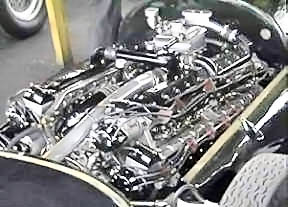V16
A V16 is an internal combustion engine in V configuration, having 16 cylinders. Engines of this number of cylinders are not common.
A V16 engine is perfecly balanced regardless of the V angle without having to resort to the use of counter-rotating balancing shafts which are necessary on medium and large Straight-4 and V8 engine configurations. In addition, an angle that is a multiple of 45° will give even firing, this makes 45°, 90° and 135° Vs optimal solutions.
V16 engines have been used in certain luxury and high-performance automobiles, mostly for their smoothness (low vibration) since it is possible to make a V8 or V12 as large and powerful as one could possibly want in an automotive application. Greater numbers of cylinders are also perceived as a status symbol.
Automotive history
Consumer automobiles
Howard Marmon had begun working on the world's first V16 engine in 1927, but was unable to complete the production Sixteen model until 1931. By that time, Cadillac had already introduced their V-16, designed by ex-Marmon engineer, Owen Nacker. Peerless, too, was developing a V16 with help from an ex-Marmon engineer, James Bohannon.
The Cadillac V-16 was the most exclusive model of the marque from January 1930 until 1940, with the Cadillac V16 engine. Two types of the V16 were built. From 1930 to 1937, this was a 425 in³ (7.0 L) with a 45° V. For 1938, a new design was introduced with 431 in³ (7.1 L) and an angle of 135°; this resulted in a much lower car profile.
By contrast, the Marmon Sixteen was a 45° engine made almost entirely out of aluminum. Like modern engines, it used pressed steel cylinder liners. Just 400 Marmon Sixteens were produced between 1931 and 1933.
In 1988, a joint business venture between Claudio Zampolli and musician Giorgio Moroder produced the Cizeta-Moroder with the only modern V16 engine. It began production in 1991 but only a few cars were produced before the company closed its doors for good.
Cadillac revived the V16 concept in 2003 with a General Motors concept car, the Cadillac Sixteen. This car used a 1000 hp (750 kW) Northstar V16.
The Rolls-Royce 100EX has also a V16, but it is not clear whether or not BMW intends to put it into production.
Racing
In auto racing, the V16 was used in Grand Prix by the mid-engined Auto Unions that rivalled the Mercedes from 1933 to 1938.
It has only been used once in the post WWII era, by BRM. Most unusually, this was a 135° V 1.5 L supercharged powerplant. This engine was a failure despite being powerful—officially, it produced 550 hp (410.1 kW) but likely delivered around 500 hp (372.8 kW). With such a small displacement per cylinder it delivered this power in a narrow RPM range. This made the car difficult to handle, but the sound made by the small 16 cylinders has been described as 'unforgettable.'
Other applications
Another use for the V16 powerplant is in large diesel engines. Here, manufacturers tend to work with a common cylinder size across a wide range of engines, and size the engine by the number of cylinders for different power requirements. Thus, many users of large diesel engines such as railroad locomotives use V16 powerplants, including many General Motors Electro-Motive Division locomotives.
| Piston engine configurations | |
|---|---|
| Straight | Single, 2, 3, 4, 5, 6, 8, 9, 10, 12, 14 |
| V | 2, 4, 5, 6, 8, 10, 12, 16, 20, 24 |
| Flat | 2, 4, 6, 8, 10, 12, 16, H |
| W | 8, 9, 12, 16, 18 |
| Other inline | H, VR, Opposed, U (Square), X |
| Other | Hemi, Radial, Rotary, Pistonless, Deltic, (Wankel) |
| Heat engines | |
|---|---|
| Stroke cycles One • Two • Four • Six • | |
| Engine types Gas turbine • Piston • Jet • Rocket engine • Steam engine • Stirling engine • Tschudi• Twingle Rotary • Wankel • Free-piston • Britalus • Coomber • Swing-piston • Orbital • Quasiturbine | |
| Valves Cylinder head porting • D slide • Four-stroke • Manifold • Multi • Piston • Poppet • Sleeve | |
| Piston layouts Single cylinder • Straight • Opposed • Flat • V • W • H • Deltic • Radial • Rocket engine nozzle • Rotary • Stelzer • Controlled Combustion • Bourke | |
| Motion mechanisms Cam • Connecting rod • Coomber rotary • Crank • Crank substitute • Crankshaft • Linkages (Evans • Peaucellier-Lipkin • Sector straight-line • Watt) • Double acting/differential cylinder | |
| Thermodynamic cycle |
